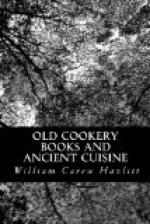He mentions in another place that the cooks washed their utensils in hot water, as well as the plates and dishes on which the victuals were served.
Mr. Wright has cited an instance from the romance of “Doon de Mayence,” where the guards of a castle, on a warm summer evening, partook of their meal in a field. Refreshment in the open air was also usual in the hunting season, when a party were at a distance from home; and the garden arbour was occasionally converted to this kind of purpose, when it had assumed its more modern phase. But our picnic was unknown.
ETIQUETTE OF THE TABLE.
Paul Hentzner, who was in England at the end of the reign of Elizabeth, remarks of the people whom he saw that “they are more polite in eating than the French, devouring less bread, but more meat, which they roast in perfection. They put a good deal of sugar in their drink.”
In his “Court and Country,” 1618, Nicholas Breton gives an instructive account of the strict rules which were drawn up for observance in great households at that time, and says that the gentlemen who attended on great lords and ladies had enough to do to carry these orders out. Not a trencher must be laid or a napkin folded awry; not a dish misplaced; not a capon carved or a rabbit unlaced contrary to the usual practice; not a glass filled or a cup uncovered save at the appointed moment: everybody must stand, speak, and look according to regulation.
The books of demeanour which have been collected by Mr. Furnivall for the Early English Text Society have their incidental value as illustrating the immediate theme, and are curious, from the growth in consecutive compilations of the code of instructions for behaviour at table, as evidences of an increasing cultivation both in manners and the variety of appliances for domestic use, including relays of knives for the successive courses. Distinctions were gradually drawn between genteel and vulgar or coarse ways of eating, and facilities were provided for keeping the food from direct contact with the fingers, and other primitive offences against decorum. Many of the precepts in the late fifteenth century “Babies’ Book,” while they demonstrate the necessity for admonition, speak also to an advance in politeness and delicacy at table. There must be a beginning somewhere; and the authors of these guides to deportment had imbibed the feeling for something higher and better, before they undertook to communicate their views to the young generation.
There is no doubt that the “Babies’ Book” and its existing congeners are the successors of anterior and still more imperfect attempts to introduce at table some degree of cleanliness and decency. When the “Babies’ Book” made its appearance, the progress in this direction must have been immense. But the observance of such niceties was of course at first exceptional; and the ideas which we see here embodied were very sparingly carried into practice outside the verge of the Court itself and the homes of a few of the aristocracy.




